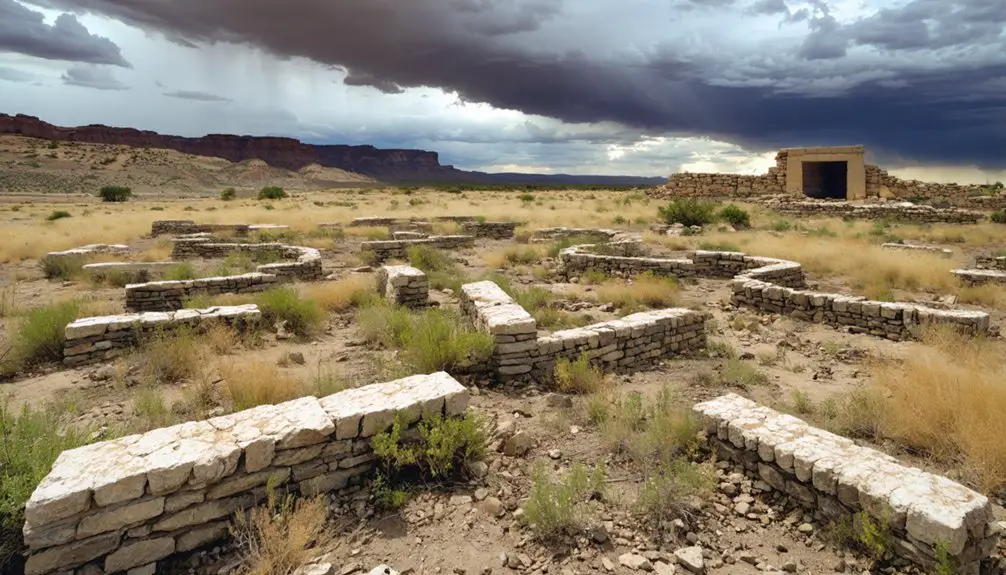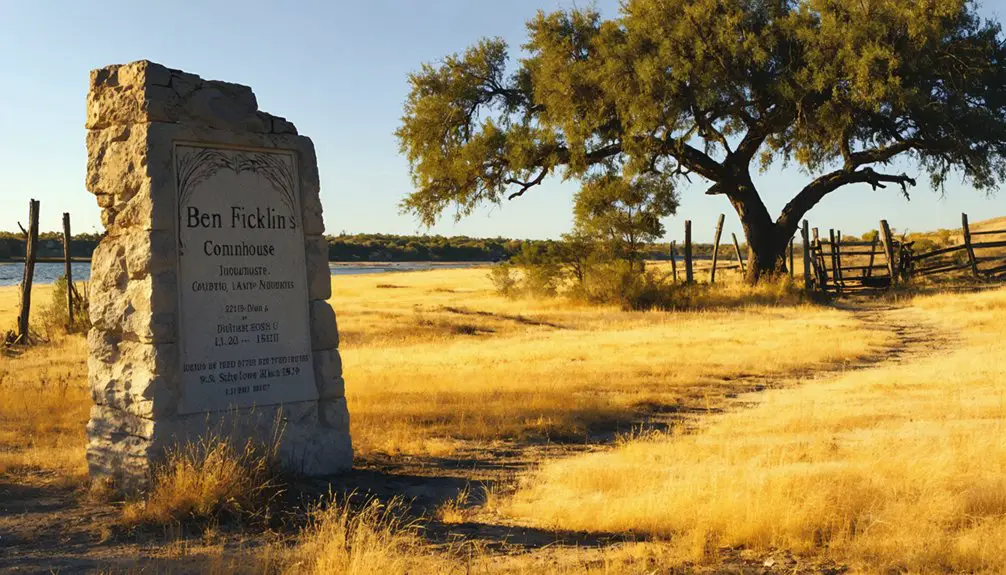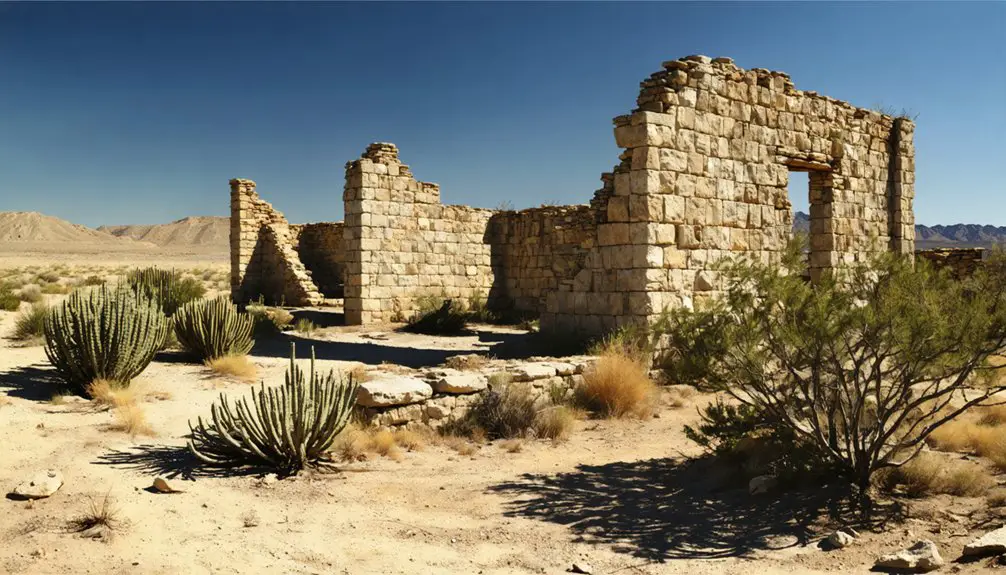You’ll find Ben Ficklin’s remains near San Angelo, Texas, where this former Tom Green County seat once thrived as an important frontier settlement. Named after Confederate major Benjamin Ficklin, the town flourished from 1875-1882 with over 600 residents, a courthouse, and essential services. A catastrophic flood in August 1882 devastated the community, claiming 65 lives and forcing survivors to abandon the settlement. The site’s dramatic transformation from county seat to ghost town reveals one of Texas’s most compelling frontier tales.
Key Takeaways
- Ben Ficklin was Tom Green County’s first county seat, established in the 1860s near the Concho Rivers in Texas.
- The town flourished as a major frontier settlement with 600 residents, a courthouse, post office, and school by 1879.
- A catastrophic flood in August 1882 destroyed the town, killing 65 people and sweeping away most buildings.
- After the flood, survivors abandoned Ben Ficklin and relocated to nearby San Angelo, which became the new county seat.
- Today, Ben Ficklin exists only as a ghost town, with few visible remains of its once-thriving frontier community.
The Birth of a Frontier Settlement
During the late 1860s, Ben Ficklin emerged as a strategic frontier settlement near the confluence of North and Middle Concho Rivers in Tom Green County, Texas.
The town’s establishment coincided with the founding of Fort Concho in 1867, creating a significant supply and trading hub where you’d find soldiers, settlers, and traders maneuvering frontier challenges. Military forces, including the 4th Cavalry, maintained a strong presence in the area. In 1875, Ben Ficklin achieved prominence when it was selected as the first county seat of Tom Green County.
As open ranges stretched across the landscape, pioneering ranchers introduced cattle and sheep from California and New England, shaping the settlement’s economic foundation.
The town’s location proved essential for mail service operations and frontier transportation, making it a nexus for regional commerce and communication.
Despite the untamed nature of the West Texas frontier, Ben Ficklin’s settlement dynamics fostered a diverse community where military personnel, ranchers, and traders forged new opportunities.
Origins Behind the Town’s Name
You’ll find the town’s name originates from Benjamin Franklin Ficklin, a Confederate major who owned the 640-acre parcel where the settlement was established.
Francis Taylor, who inherited the land after Ficklin’s death in 1871, chose to honor his friend’s memory by naming the town “Benficklin,” which locals later separated into “Ben Ficklin” for easier use.
The namesake’s legacy as the founder of the Pony Express and manager of the Central Overland California & Pike’s Peak Express Company made him a fitting figure for whom to name this frontier outpost along the San Antonio-El Paso mail route.
Taylor partnered with William Kelly and Charles Metcalfe to establish a formal townsite layout in 1873.
The town’s strategic location was enhanced by Ficklin’s earlier development of the Concho Mail Station, which established an important transportation link in the region.
Mail Pioneer’s Lasting Legacy
The frontier town of Ben Ficklin earned its name from Benjamin Franklin Ficklin, a pioneering mail service entrepreneur whose influence shaped communication across the American West.
You’ll find his lasting impact most evident in the establishment of essential mail routes between San Antonio and El Paso, which proved critical during the post-Civil War period when federal presence wavered.
As a founder of the Pacific Telegraph Company and a key figure in the Pony Express’s creation, Ficklin’s innovations connected isolated communities through expanding communication networks. His extensive experience with Russell, Majors & Waddell freight line in the early 1850s provided him valuable insights into western transportation systems.
His vision extended beyond simple mail delivery – he helped establish the region’s first regular post office in 1875, transforming the area into a significant hub that would unite frontier settlements during a time of instability and limited law enforcement.
The 5-cent stamp rate for letters weighing under half an ounce helped maintain affordable communication for settlers across distances up to 300 miles.
Benjamin Ficklin’s Military Career
Charging headlong into military life at age 16, Benjamin Franklin Ficklin’s service record began at Virginia Military Institute in 1844, where his rebellious nature first surfaced through a notorious prank involving a howitzer aimed at cadet barracks.
Despite this rocky start, you’ll find his military legacy spans multiple conflicts and territories. After serving in the Mexican-American War, where he was wounded and left for dead, Ficklin’s frontier service included essential roles during the Utah War as a scout and courier. His early departure from VMI led to his dismissal in 1846, though he would later return to graduate.
He’d later distinguish himself managing the Pony Express and serving the Confederacy as quartermaster general. Before his death in 1871, he worked as a Confederate purchasing agent in Europe, securing vital supplies for the Southern cause. His final military contributions involved running blockades along Confederate coastlines until his death in 1871, marking the end of a remarkable career that shaped America’s western expansion.
From Benficklin to Ben
Named after the enterprising Benjamin Franklin Ficklin, originator of the Pony Express, this pioneering Texas settlement established itself near Fort Concho in the early 1870s.
The town’s name reflects an intriguing history of surname variations within the Ficklin family line, including Ficklen, Fickling, and Fickin. While Ficklin descendants largely adopted the “Ficken” spelling, the town preserved the “Ficklin” version in its official designation.
You’ll find Ben Ficklin’s legacy deeply woven into the region’s development, as his Concho Mail Station and stage line to San Antonio proved instrumental in attracting early settlers. The town’s prominence peaked when it won the county seat in 1875. The residents of Ben Ficklin considered themselves more civilized and refined compared to their neighbors in San Angelo.
Though the devastating flood of 1882 transformed Ben Ficklin into a ghost town, its name endures through local landmarks, including the cemetery, roads, and reservoirs that dot modern San Angelo’s landscape.
Life in Early Ben Ficklin
In Ben Ficklin’s early days, you’d find settlers and ranchers engaged in daily activities centered around the stage station, courthouse, and post office – three essential hubs of pioneer life.
You’d see cattle drives along the Goodnight-Loving Trail bringing commerce and trade opportunities to the town’s merchants, while tensions sometimes flared between cattle ranchers and incoming sheep operations.
Social life revolved around the downtown area where Mexican, White, and African American residents would gather for county business and community affairs, reflecting the town’s diverse population of over 3,600 by 1880.
Daily Pioneer Activities
Life pulsed through Ben Ficklin’s pioneer community as residents established essential governance structures and daily routines around the town’s role as Tom Green County’s first seat in 1875.
You’d find pioneers engaged in important activities that sustained their frontier existence, from pioneer craftsmanship to managing community resources.
Their daily lives centered around:
- Building and maintaining the town’s modest courthouse, paying just $10 monthly in rent
- Gathering essential materials like wood for construction and fuel
- Practicing key trades such as blacksmithing and wagon repair
- Coordinating stage depot operations for mail and passenger services
- Participating in communal meetings and elections to shape local governance
The confluence of the Middle and North Concho Rivers shaped their routines, while the harsh West Texas climate demanded resilience in farming, construction, and daily survival.
Commerce and Trade
While Major Benjamin F. Ficklin established his stagecoach stop along the South Concho River, you’d find a bustling commercial center emerging around transportation networks that connected Fort Concho to San Antonio.
As you explored this frontier hub, you’d discover a strategic operation built on 640 acres near crucial springs, where trade routes intersected to facilitate the movement of goods, mail, and people.
You’d witness merchants exchanging agricultural products and livestock for manufactured goods, while the stage line’s infrastructure supported essential services like blacksmithing and lodging.
The Concho Mail Station became your lifeline to the outside world, though commerce remained vulnerable to nature’s whims and regional isolation.
The freight and mail enterprises you’d rely on weren’t just businesses – they were the foundations of Ben Ficklin’s early economic survival.
Social Gatherings Downtown
Beyond the commercial bustle of Ben Ficklin’s trade routes, you’d find a vibrant social scene centered around the town square and its first Tom Green County Courthouse.
Unlike its rowdier neighbor San Angela, Ben Ficklin cultivated a more refined atmosphere of community engagement through its social venues and civic spaces.
- The adobe subscription school served as an educational hub where families gathered to strengthen community bonds.
- Church buildings dotted the downtown landscape, offering spiritual fellowship and social connection.
- The town square hosted seasonal events and market days, bringing citizens together for public interaction.
- The courthouse fostered civic participation through community meetings and local governance.
- A distinguished hotel welcomed visitors and provided a sophisticated setting for social occasions, connecting residents with travelers from beyond Ben Ficklin’s borders.
The Rise as Tom Green County Seat
The establishment of Ben Ficklin as Tom Green County‘s seat in 1875 marked a pivotal moment in West Texas’ administrative history.
You’ll find that county politics played a significant role as Francis Corbett Taylor and William Stephen Kelly rallied support from stage line workers, military officers, and local ranchers to secure the designation.
The town’s rapid community development included a post office, subscription-based school, and church lots, fostering a family-oriented atmosphere that contrasted sharply with San Angela’s rowdier reputation.
By 1879, you’d have seen a thriving population of 600 residents and a temporary adobe courthouse.
In 1882, they completed a permanent two-story stone courthouse, cementing Ben Ficklin’s status as the region’s administrative hub near Fort Concho’s strategic water spring.
The Devastating Flood of 1882

Severe rainfall on August 23, 1882, set in motion one of West Texas’ most devastating natural disasters, forever altering Ben Ficklin’s destiny.
After a particularly wet August that saturated the ground, multiple rivers and creeks surged toward the town. The flood aftermath left only the courthouse, jail, and one residence standing, while claiming 65 lives.
- Floodwaters rose 15 feet high on the courthouse, destroying nearly every structure.
- A heroic jailer used his wooden leg to prop open the cell door, saving 13 prisoners.
- A mother with a newborn baby survived multiple rescue attempts.
- Cowboys rescued passengers from a buggy washing downstream.
- Survivors found themselves stranded without shelter or provisions.
The disaster led to Ben Ficklin’s abandonment, with most survivors relocating to San Angela, which became the new county seat.
From County Seat to Ghost Town
Founded in 1868 on land purchased by Major Benjamin F. Ficklin, the town quickly established itself as Tom Green County’s seat through campaigns led by Francis Taylor and William Kelly.
You’ll find that Ben Ficklin’s early years showed remarkable frontier challenges and community resilience, growing to 600 residents by the late 1870s.
The town’s infrastructure expanded with a stone courthouse, jail, stores, and homes, while its economy thrived on stage line operations and Fort Concho commerce.
Unlike rowdy San Angela, Ben Ficklin attracted professionals and military personnel seeking an orderly community.
However, the devastating flood of August 24, 1882, destroyed most buildings except the courthouse, jail, and two houses.
This catastrophic event marked the end of Ben Ficklin’s prominence, transforming a once-promising county seat into a ghost town.
What Remains Today

After the catastrophic 1882 flood, Ben Ficklin’s physical remnants gradually vanished over time, leaving behind sparse traces of its frontier legacy.
You’ll find few ghost town remnants today, though the cemetery preservation efforts stand as a symbol of the town’s enduring historical significance.
- The original courthouse lives on through its stones, now part of a San Angelo high school building at 100 Magdalen Street
- Ben Ficklin Road traces the old town’s path, a symbolic link to its pioneering past
- The historic cemetery sits proudly on a hilltop, housing flood victims and county founders
- A 1965 Texas Historical Commission marker commemorates the town’s importance
- The surrounding landscape, though modernized, still tells the story of that fateful flood through its converging waterways
Historical Impact on West Texas
Despite its relatively brief nine-year existence as Tom Green County’s seat, Ben Ficklin played a pivotal role in shaping West Texas’s development during the 1870s and early 1880s.
You’ll find its cultural influences reflected in the region’s early commitment to organized civic development, as evidenced by its $18,000 courthouse investment and structured townsite planning.
The town’s tragic destruction in 1882 dramatically altered regional settlement patterns, accelerating San Angelo’s growth and prompting a reevaluation of town placement throughout West Texas.
Ben Ficklin’s legacy as a “civilized” alternative to San Angelo’s rougher character helped establish standards for frontier governance.
Today, you’ll recognize its lasting impact in the way the catastrophic flood influenced future urban planning decisions, particularly regarding riverside development and disaster preparedness in West Texas communities.
Frequently Asked Questions
Were There Any Famous Gunfights or Notable Outlaws in Ben Ficklin?
Like a tumbleweed rolling through empty streets, you won’t find any documented gunfights history or outlaw legends in this town. Records show Ben Ficklin’s violence was limited to regional stagecoach raids.
What Happened to Benjamin Ficklin’s Original Land Deed After the Town’s Destruction?
You’ll find Francis Taylor retained land ownership after Ficklin’s death, but historical records don’t clearly show the deed’s fate following the 1882 flood that destroyed the town.
Did Any Businesses From Ben Ficklin Relocate to San Angelo?
While you can’t find direct records of business relocation, you’ll see that San Angelo naturally absorbed Ben Ficklin’s economic impact when displaced residents and county functions moved there after the devastating 1882 flood.
Were There Native American Settlements Near Ben Ficklin Before Its Establishment?
Yes, you’ll find evidence of Native American settlements, particularly Jumano Indians, who lived near the future Ben Ficklin site. Historical significance includes their rock basins, grinding holes, and graves throughout the Concho region.
How Did Mail Delivery Continue After Ben Ficklin’s Destruction?
You’d find mail routes quickly shifted to nearby settlements and military posts, with contractors adapting delivery paths around the ghost town while maintaining essential communication links across West Texas’s frontier communities.
References
- https://www.tshaonline.org/texas-day-by-day/entry/164
- https://www.benficklincemetery.org/the-town-of-ben-ficklin
- https://www.gosanangelo.com/story/news/local/2019/01/17/san-angelo-texas-ben-ficklin-sign-2019/2603222002/
- https://www.benficklincemetery.org/san-angelo
- https://www.texasalmanac.com/places/ben-ficklin
- https://www.texasescapes.com/TexasGhostTowns/BenFicklinTexas/BenFicklinTx.htm
- https://www.tshaonline.org/handbook/entries/tom-green-county
- https://www.texasbeyondhistory.net/forts/66-75.html
- https://digital.library.unt.edu/ark:/67531/metadc699709/m2/1/high_res_d/1002503191-Allen.pdf
- https://www.texasalmanac.com/places/san-angelo



